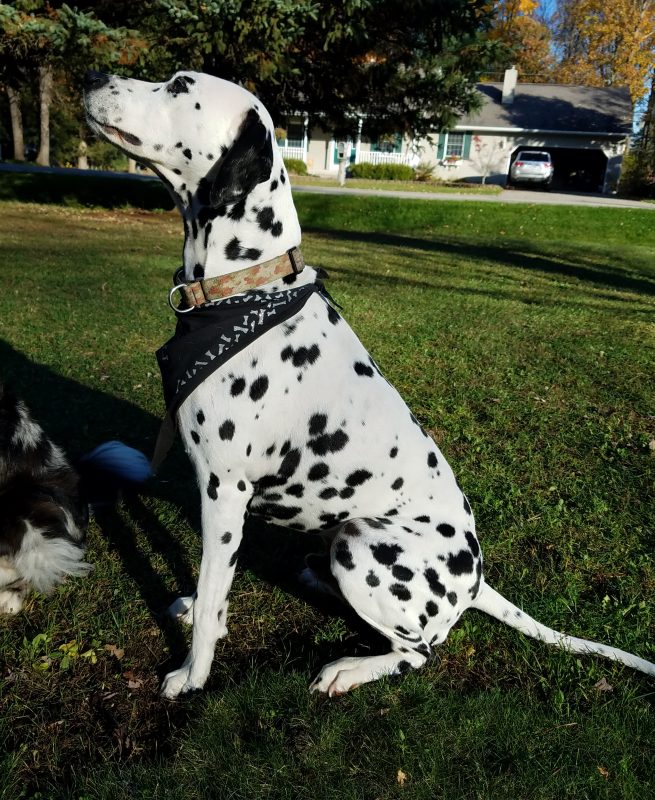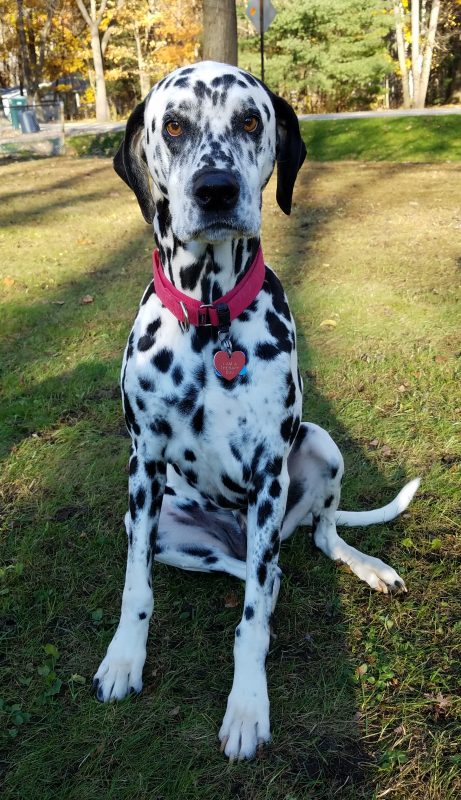Your Dog Doesn’t Know Sit; Achieving the Perfect Sit
by Colleen Lum LVT, CCRA
What is a proper sit and why does it matter?
Sloppy sit. Puppy sit. We’ve all seen the adorable pudgy puppy sitting on a hip with his legs off to the side or the grey faced dog rolled back on his rump with

Logan is demonstrating a beautifully tucked sit. His hind limbs are collected underneath himself with his knees and toes in alignment.
both feet extended out in front of him. How do they look when they try to stand? Are they struggling to get their legs underneath them or pulling themselves up with their front legs? How does their back look? Is it hunched over like your office co-worker hovering over their keyboard for hours? This seemingly minuscule oversight of proper posture is actually quite important in the overall health of any dog, whether it be a walk around the block companion to the high level sporting athlete. Let’s start with the basics.
The GOOD…
What is a proper sit then? If you look at the picture to the right, we can break it down. Observe the neatly tucked hind limbs. Flexed and positioned squarely beneath the dog’s body. Notice the upright position of his back and the even placement of the front limbs. When the dog starts out in this position, he or she is able to transition to a stand by pushing off with equal momentum of both hind limbs. And by doing so, is not overusing or straining the back or front limbs. This proper sit is also used as a home base or foundation for many of the targeted exercises we utilize here for basic strengthening. If a patient cannot get themselves in this position we either start re-teaching this or use a modified version if they physically cannot (severe osteoarthritis (OA) causing decreased ROM).
The BAD…

George is sitting off on his right hip, demonstrating poor posture.
So my dog doesn’t sit “properly”, what’s the big deal? A sloppy sit from early on can slowly develop into chronic pain and overall a weak spine and abdominal (core) musculature. That being said, let’s take a look at a “sloppy” sit. With the hind limbs in this position, this dog cannot utilize them to rise from a sit and therefore will have to compensate. This compensation usually originates in the back, neck and front limbs and manifests as pain and tension. This dog will likely shift his weight forward, overloading his shoulders, elbows and carpal joints, and rely on them heavily, as well as his back to pull himself up into a stand.
Poor posture contributes to weakening of the core muscles in animals, just like it does in people. This can cause myofascial back pain, spinal luxation, and spinal muscle tension. Can you see how over time this can snowball causing joint pain, muscle loss and worsening mobility issues?
And the Solution!
So you’re puppy or adult dog has a less than proper sit. Not to worry, it can be retaught! There are several ways to reteach this depending on how each dog learns.
- Asking your dog to sit in a narrow space or box
- Asking your dog to sit on an elevated platform
- Asking your dog to sit next to a wall
By modifying the location in which you have your dog perform the sit, it requires them to “collect” their body into a smaller space which typically involves placing the limbs flexed underneath them. This “collection” is also a phrase that you may hear us use a lot and is also called body awareness. Eventually the goal is to phase out the correction tool (box, platform, etc.) and still have a proper sit and maintain it. It is also very important to reward (praise, food, toy, etc) when a proper sit is achieved to reinforce the desired position (let your dog know that “yes! That’s what I’m talking about!). In the case of our older patients with OA, we may have to modify this somewhat to account for their limitations in their joint range of motion.
CONCLUSION
For what seems like such a simple thing, how your dog plants his or her butt can make a significant difference in how they maintain their mobility and their core/hind limb strength as they age. Thankfully it can be easily retaught for many cases and for those tricky or stubborn dogs, we are more than happy to help guide and assist owners through it. Now you will be critiquing every dog you see on how their sit looks. Once you see it, it can’t be unseen.
